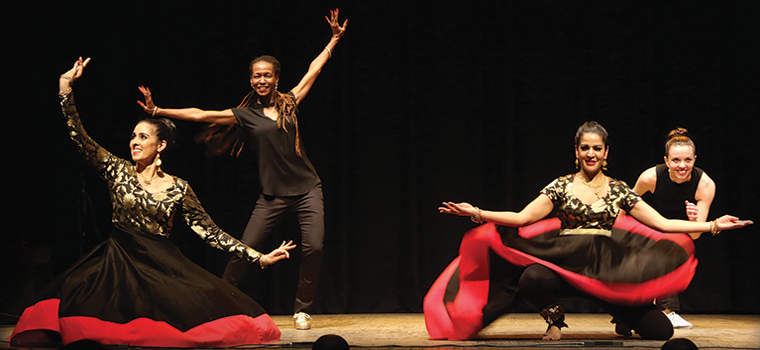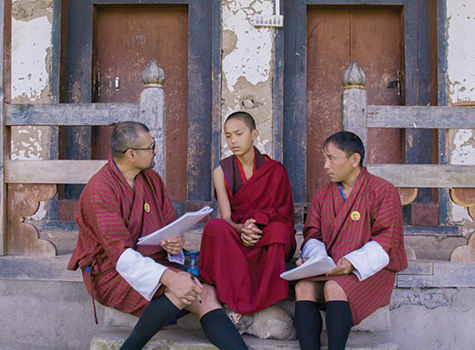By Preethi Sriram

Indian Classical Dance styles and American Tap Dance are literally world’s away from each other. Indian Classical Dance is known as a very structured form of dance. There are currently eight recognized classical dance styles from the different parts of India which include Bharthanatyam, Kuchipudi, Kathakali, Mohiniattam, Kathak, Odissi, Sattriya, and Manipuri.
As an adult student of Bharthanatyam, I have grown up with the very rigid and traditional dance style. The technique and how it is taught can be considered strict in that there are certain concepts that must be followed.
The teacher, or the guru, plays a very important role in the student’s experience of learning of the art form. The costumes are unique to the specific dance style and each of the dances that are performed in a traditional format consisting of learning the compositions in a methodical fashion. When trying to expose myself to other Indian classical dance styles of Kathak and Odissi, there was a similar concept of structure that makes the dance styles very distinct.
Many of these forms also have concepts noted within the Natyashastras or the performing arts treatise. The styles include intricate hand and feet work, as well as storytelling. The dancers may wear bells on their ankles, which gives the sound of the beat. As music is integral to the dance form, the music consists of vocalists and instrumentalists who are also trained in the classical art form of music.
Travelling to the other side of the world for dance is American Tap Dance. I am not as familiar with this dance style. I have watched Shirley Temple in some movies, and she as a child star in the 1930s, charmed the audience with her tap dancing.
When looking up the history of Tap dance, the search revealed that Tap dance takes inspiration from African forms of arts as well as an Irish dance form known as clogging.
From a first glance and introductions, Indian Classical Dance and Tap are literally world’s away from each other: Kathak, a classical Indian dance form, and Tap, an American Dance Style, would seem as if there was no connection to each other.
Yet, when these worlds of dance collide and fuse, what may be the outcome?
One of the shows that I had seen that was performed in the NC Triangle was the show Speak, presented by the Leela Dance Collective. I was intrigued by the description for the show as it was noted to be a fusion between the classical Indian dance form of Kathak and of American Tap dance style.
I was excited to see the experimentation of the combination of both styles.
The show was in the Stewart Theatre Center at the Talley Student Union Center at NC State. The set-up of the stage was an exciting feeling to be able to witness. On the left-hand side of the stage, the classical Indian singers were positioned and sitting down on a raised platform. On the right side of the stage, there was a “Western” set up, with a jazz band.
The first piece of the program started out with the dancers performing an invocatory piece to Mother Kali, where both the Kathak dancers and the Tap dancers were introduced on the stage. The following pieces were showcases of Kathak and Tap Items. It was fascinating to watch the juxtaposition of the Kathak and Tap as both are noted forms for the feet work and are unique in their styles.
A piece that I really enjoyed was when the dancers were “talking” to each other in “dance talk”. Imagine meeting another person who does not speak your language. How do you introduce yourself?
The dancers “talked” to each other through using the dance talk vocabulary which was through the “language” of “bols” and “scat talk.” The Kathak dancers said the “bols” and the tap performer “talked” in the language of “scat” talk. While both would seem pole opposites to each other on its own, when combined on stage, it seemed one.
Even though Kathak and Tap may seem worlds apart, on stage, while the uniqueness and individuality of each style do stand out, the similarities that run through each can be seen as well. Watching the fusion of the two dance forms and hearing the fusion of the dance styles of music was the unity in diversity message that was being conveyed.
While the styles of Kathak and Tap may be different, the combination of the two formats demonstrates that there is something similar underlying all of us as well. The language used to express this concept depends on the person and their individual language style.
A person with a spiritual background may use the language that this similarity in us is “atma” or soul, a person with a science background may find the similarity in all of us by using the science language and saying that we all have DNA running through us and are made of electrons.
A person of a musical background may say the similarity is that we all have a “beat” within us.
This is where I feel that the arts of music and dance can help people transcend their vantage point of division to give a different vantage point of unity in diversity. Where words, books, talks and lectures could fall short, music and dance are a different “language” that can help to unite people. In this way, the arts provided a channel to accomplish that message.
Watching a fusion dance helps me to remember one of the reasons I wish to continue the art form of dance; It is to remember that there can be both unity and diversity and unity in diversity and it compliments each other well.
Preethi Sriram is a classical dance enthusiast and lifelong learner of dance.
Contact: [email protected]



